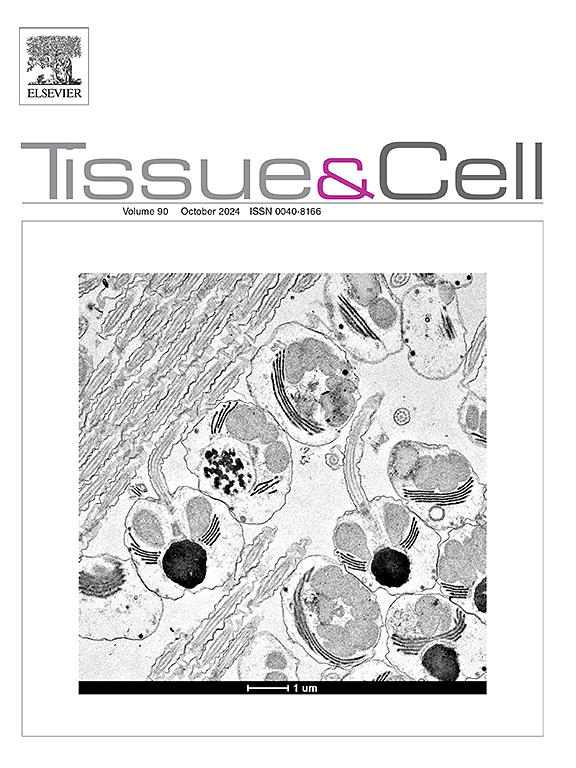人胎盘提取物(HPE)通过靶向PI3K/mTOR/GSK3β信号通路,调节海马细胞凋亡和再生,对抗糖尿病性脑神经退行性变
IF 2.7
4区 生物学
Q1 ANATOMY & MORPHOLOGY
引用次数: 0
摘要
糖尿病(DM)与神经变性密切相关,主要通过胰岛素信号受损和炎症驱动的神经元细胞死亡。本研究旨在探讨人胎盘提取物(HPE)对链脲佐菌素(STZ)诱导的糖尿病大鼠模型海马完整性和神经发生的神经保护作用。方法将大鼠随机分为对照组、HPE组、STZ组和STZ + HPE组。Annexin V-FITC/PI染色通过流式细胞术评估凋亡,ELISA检测海马PI3K、mTOR和GSK3β水平。采用甲苯胺蓝染色和透射电镜(TEM)分析组织学和超微结构变化,免疫组织化学标记物GFAP、Ki67和caspase-3分别评估星形胶质细胞活化、细胞增殖和神经元凋亡。ResultsSTZ显著增加早期和晚期凋亡细胞(4.30 ±0.15 %和16.21±0.08 %)和坏死(3.28 ±0.58 %),同时减少可行的细胞 76.05±0.84 %,相比控制(93.16 ±0.29 %)。糖尿病大鼠的HPE治疗显著逆转了这些变化(p <; 0.001)。此外,STZ下调PI3K(31.46 ±2.25 pg /毫克)和mTOR(1.59 ± 0.10纳克/毫克),而移植GSK3β(3.65 ± 0.12纳克/毫克)。HPE治疗恢复PI3K(41.28 ±2.49 pg /毫克),mTOR(2.24 ± 0.15纳克/毫克),并降低GSK3β(2.74 ± 0.28纳克/毫克)。组织学上,STZ引起锥体神经元变性,核膜不规则,CA3区细胞质空泡形成,HPE改善了这一现象。糖尿病大鼠的GFAP免疫反应性明显下降,在HPE治疗后增强,表明反应性星形胶质细胞增生减弱。此外,HPE恢复了CA3区域的ki67阳性增殖细胞,逆转了糖尿病诱导的海马神经发生的下降。Caspase-3免疫染色显示STZ大鼠细胞凋亡升高,HPE显著降低STZ大鼠细胞凋亡,恢复到与对照组相当的水平,证实了其抗凋亡作用。结论shpe通过恢复胰岛素信号通路(PI3K/mTOR/GSK3β通路),抑制细胞凋亡和炎症,促进神经发生,显著减轻stz诱导的海马损伤。HPE对caspase-3介导的细胞凋亡和ki67驱动的细胞增殖的联合作用突出了HPE在神经保护和再生中的双重作用。这些发现支持HPE在治疗糖尿病相关神经退行性改变方面的治疗潜力。本文章由计算机程序翻译,如有差异,请以英文原文为准。
Human placental extract (HPE) counteracts diabetic brain neurodegeneration by targeting PI3K/mTOR/GSK3β signaling and modulates hippocampal apoptosis and regeneration
Objective
Diabetes mellitus (DM) is closely associated with neurodegeneration, predominantly through impaired insulin signaling and inflammation-driven neuronal cell death. This study aimed to evaluate the neuroprotective effects of human placental extract (HPE) on hippocampal integrity and neurogenesis in a streptozotocin (STZ)-induced diabetic rat model.
Methods
Male rats were randomly assigned into four groups: control, HPE, STZ, and STZ + HPE. Apoptosis was assessed via flow cytometry using Annexin V-FITC/PI staining, while ELISA measured hippocampal levels of PI3K, mTOR, and GSK3β. Histological and ultrastructural changes were analyzed using toluidine blue staining and transmission electron microscopy (TEM), and immunohistochemical markers GFAP, Ki67, and caspase-3 were used to evaluate astrocyte activation, cell proliferation, and neuronal apoptosis, respectively.
Results
STZ significantly increased early and late apoptotic cells (4.30 ± 0.15 % and 16.21 ± 0.08 %) and necrosis (3.28 ± 0.58 %) while reducing viable cells to 76.05 ± 0.84 %, compared to controls (93.16 ± 0.29 %). HPE treatment of diabetic rats significantly reversed these changes (p < 0.001). Moreover, STZ downregulated PI3K (31.46 ± 2.25 pg/mg) and mTOR (1.59 ± 0.10 ng/mg), while upregulating GSK3β (3.65 ± 0.12 ng/mg). HPE treatment restored PI3K (41.28 ± 2.49 pg/mg), mTOR (2.24 ± 0.15 ng/mg), and reduced GSK3β (2.74 ± 0.28 ng/mg).
Histologically, STZ caused degeneration of pyramidal neurons, irregular nuclear membranes, and cytoplasmic vacuolation in the CA3 region, which were ameliorated by HPE. GFAP immunoreactivity, markedly declined in diabetic rats, was augmented following HPE treatment, indicating attenuation of reactive astrogliosis. Additionally, HPE restored Ki67-positive proliferative cells in the CA3 region, reversing the diabetes-induced decline in hippocampal neurogenesis. Caspase-3 immunostaining showed elevated apoptosis in STZ rats, which was significantly reduced by HPE, restoring levels comparable to those of controls and confirming its anti-apoptotic effect.
Conclusions
HPE significantly mitigates STZ-induced hippocampal damage by restoring insulin signaling (PI3K/mTOR/GSK3β pathway), suppressing apoptosis and inflammation, and promoting neurogenesis. The combined effects on both caspase-3-mediated apoptosis and Ki67-driven proliferation highlight HPE's dual role in neuroprotection and regeneration. These findings support the therapeutic potential of HPE in managing diabetes-associated neurodegenerative changes.
求助全文
通过发布文献求助,成功后即可免费获取论文全文。
去求助
来源期刊

Tissue & cell
医学-解剖学与形态学
CiteScore
3.90
自引率
0.00%
发文量
234
期刊介绍:
Tissue and Cell is devoted to original research on the organization of cells, subcellular and extracellular components at all levels, including the grouping and interrelations of cells in tissues and organs. The journal encourages submission of ultrastructural studies that provide novel insights into structure, function and physiology of cells and tissues, in health and disease. Bioengineering and stem cells studies focused on the description of morphological and/or histological data are also welcomed.
Studies investigating the effect of compounds and/or substances on structure of cells and tissues are generally outside the scope of this journal. For consideration, studies should contain a clear rationale on the use of (a) given substance(s), have a compelling morphological and structural focus and present novel incremental findings from previous literature.
 求助内容:
求助内容: 应助结果提醒方式:
应助结果提醒方式:


